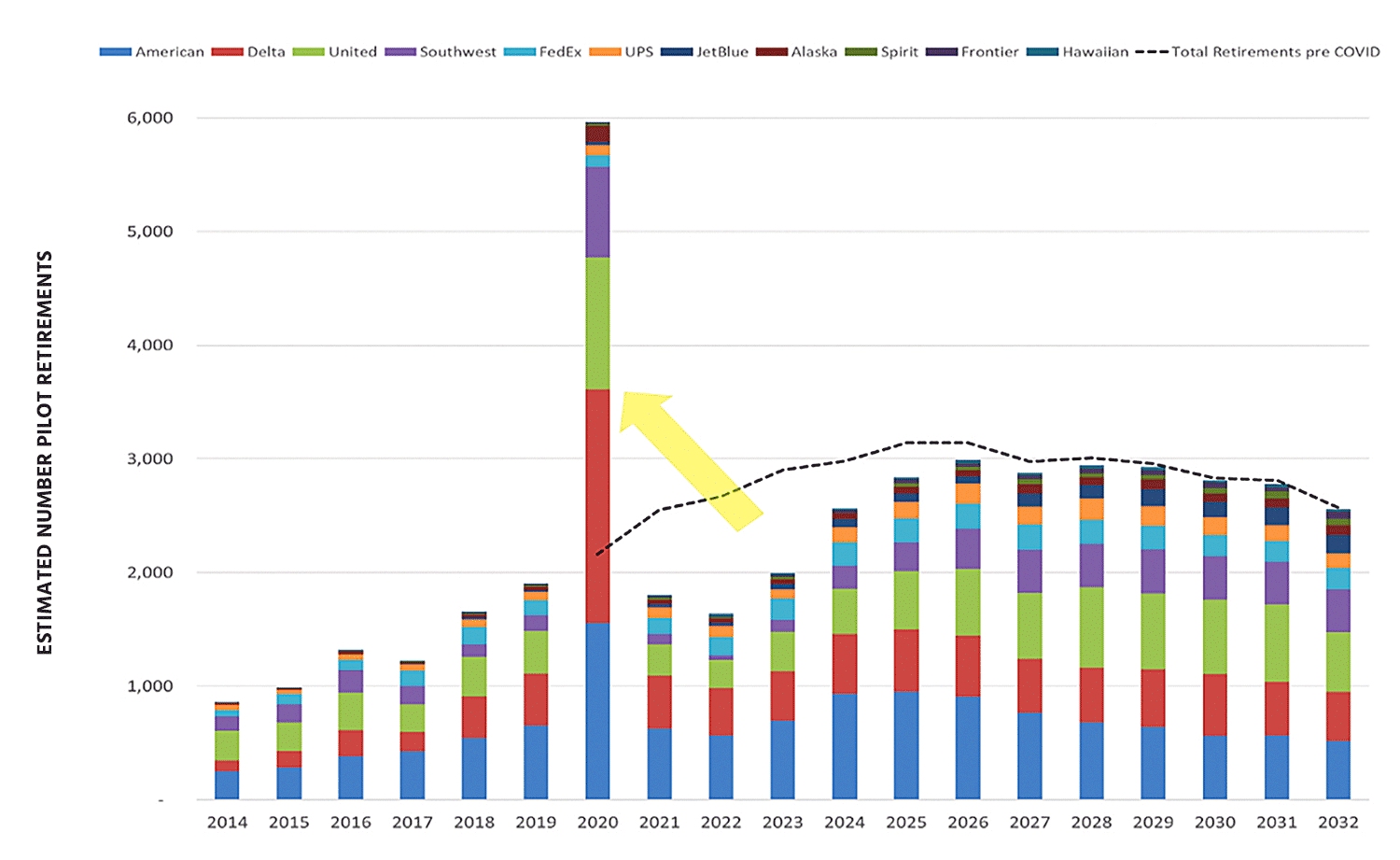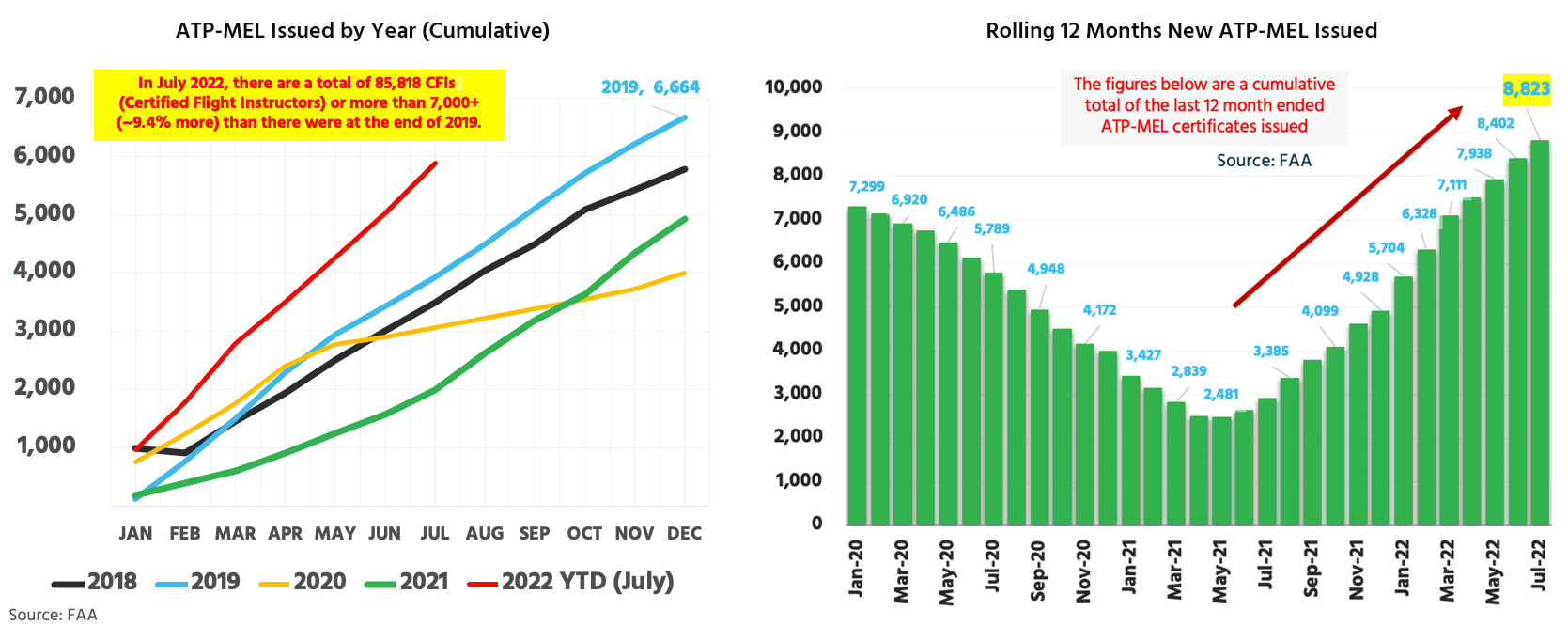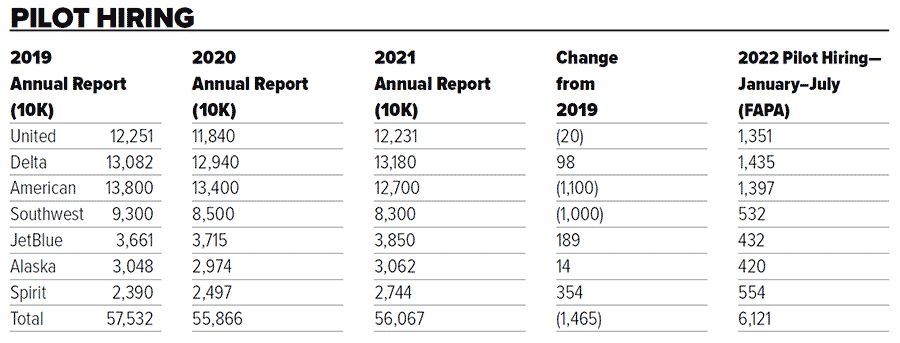The Facts About Pilot Supply
By ALPA Staff
As the airline industry recovers from the pandemic, some in the industry have used the operational difficulties facing airlines to push for a reduction in airline training and safety standards. This effort is under the guise of a so-called “pilot shortage” that, according to proponents, would require changes to established and proven safety requirements, an increase in pilot retirement age, and reductions in the safety of rural flight operations.
However, the notion of a pilot shortage is not based on facts but on operational issues and is an attempt to undermine the piloting profession and ultimately the safety of the industry.
Do the Math
Despite contrarian claims, there are 1.5 certificated pilots relative to available seat positions at FAR Part 121 carriers. Airline transport pilot (ATP) production has been strong throughout the pandemic—with a minor dip when airline hiring and flying froze, buoyed by record numbers of new ATP certificates today. In fact, the FAA has issued 8,823 new certificates year to date through July. This surpasses prepandemic numbers and may be the largest ATP production year in history.
While more pilots retired in 2020 and 2021 than in typical years, most of these were accelerated early-out retirements, and fewer retirements are expected over the next three years than previously predicted as a result. A healthy cushion of ATPs existed prior to the pandemic that more than made up for these early-outs.
In fact, publicly available data shows that today some airlines have more pilots on staff than they did in 2019. But at the same time, block hours and, consequently, domestic flight schedules for most carriers are now below 2019 levels.
So What’s Going On?
During the pandemic, airlines assumed, given the depth and scope of the pandemic’s impact, that demand for air travel would be slow to recover, taking approximately four to five years. Accordingly, most airlines bumped pilots off larger aircraft, displaced pilots across aircraft and fleet types, and put pilots on inactive status. This was a managed way for carriers to bring down their costs. But air travel demand bounced back much quicker than airlines had planned due to vaccine accessibility, pent-up spending capacity, and desire for leisure travel. The process of unwinding the displacements and bringing pilots back is costly, time-consuming, and difficult as the fixed amount of training capacity isn’t large enough for such a massive training event. Rather than admit this to the flying public, some airlines are trying to deflect blame for their own mismanagement and looking for ways to skirt proven aviation safety rules.
In contrast to frequent public pronouncements by airlines about a lack of available pilots and the harmful effect on route capacity and on-time performance, they’re typically more honest with their shareholders. When having to account to shareholders, most airlines admit the publicly available and statistically verifiable truth: they have plenty of pilots, but a training backlog, among other variables, is holding back capacity.
Estimated Number of Pilot Retirements
“Since ratifying our pilot agreement at the end of last year, we haven’t had any issues with retention or hiring. However, we’re attempting to train about four times the amount of crews versus pre-COVID levels,” admitted Jude Bricker, the CEO of Sun Country Airlines. “At the end of June, about a third of our first officers were in a training status. This resulted in a reduction for June, a peak month, of 30 percent in passenger fleet utilization versus 2019.”
“The chief issue we’re working through is not hiring but a training and experience bubble,” acknowledged Ed Bastian, the CEO of Delta Air Lines. “Coupling this with the lingering effects of COVID, and we’ve seen a reduction in crew availability and higher overtime.”
In addition, mainline and regional operators have been pulling out of certain markets with less-sustained demand, including smaller and more rural markets. Many of these markets were already struggling, but the leisure flying boom and the accelerated phaseout of 50-seat regional jets have exacerbated these communities’ losses. Again, rather than leveling with the public regarding market supply and demand, some airlines have continued to blame the fictitious pilot shortage for obvious economic-driven decisions.
8,823 New ATP-MELs Issues in the Last 12 Months
1,500+ More Than Same Period Pre-COVID (7,299) and 2,100+ More Than All of 2019 (6,664)
Congressional Action
In October 2023, FAA reauthorization, legislation that authorizes FAA programs and provides for changes to FAA laws, is set to expire. With its expiration, Congress will look to update programs and laws beginning next year. The industry push on pilot supply, despite numbers to the contrary, is laying the groundwork for a variety of management-led efforts to undermine the piloting profession and safety regulations regarding pilot training and qualifications that the public often takes for granted.
It’s very possible there will be an effort to repeal or otherwise change the first officer minimum qualifications law. After the 2009 crash of Colgan Air Flight 3407 in upstate New York and a series of other tragic airline accidents, Congress changed a host of laws to improve safety and pilot qualifications and training through the Airline Safety and Federal Aviation Administration Extension Act of 2010. The law brought sweeping reforms to FAR Part 121 airline operations and has resulted in the safest period ever in U.S. aviation history. In the two decades prior to the law’s passage, more than 1,100 individuals died in U.S. passenger airline accidents. In the 12 years since Congress required enhanced pilot training and qualifications, only two passenger fatalities have occurred—a 99.8 percent reduction in FAR Part 121 passenger fatalities.
The law requires airline first officers to have 1,500 hours of flight experience to earn an ATP but allows the FAA to give flight-experience credit toward the 1,500-hour requirement for specific academic and military training that enhances safety. The FAA undertook an extensive rulemaking and examined which types of aviation training and education programs, due to their safety-enhancing benefits, would allow FAA credit toward reducing the statutorily mandated minimum flight hours for a first officer. The FAA recognizes military aviation experience and two- and four-year aviation-related degrees with professional pilot flight training as the only means of flight-credit-hour reductions against the ATP flight experience (1,500-hour) requirements due to their superior flight training and academic classroom instruction.
In the FAA Reauthorization Act of 2018, there was a failed effort to repeal the minimum flight experience for first officers. ALPA believes the industry may push for a similar repeal, the creation of a less-safe, alternate pathway to an airline flight deck, or a move to increase student loans for certificate programs that churn out pilots in a year or less through unstructured programs. The FAA went to great lengths to determine how credits and pathways for pilot qualification and certification should work, with an exclusive focus on safety. Republic Airways’ recent efforts to circumvent the first officer qualification requirements and SkyWest’s maneuver to reduce one level of safety for rural flying are among the schemes that ALPA expects to complicate FAA reauthorization.
Further, the industry may seek to undermine the existing pathways for pilot training by trying to focus taxpayer financing toward short-term “certificate” programs that aren’t identified as safety-enhancing, aren’t always properly accredited, and may not lead to career progression. Often, these programs are focused on rapidly churning out pilot certificates, rather than creating the best possible pilot. The FAA has spent considerable time examining the merits and drawbacks for the totality of these types of programs and looks on them unfavorably. In pushing alternatives to existing FAA pathways in favor of these less-structured, less-safety-enhancing, and often cursory certificate-granting institutions, certain carriers are looking for work-arounds from the first officer qualification rules.
The rules, including those governing training and education, have long been opposed by these groups. In fact, they were implemented because of institutional failures and poor safety performance. Likely, these entities would petition the FAA for credit to these pathways, absent safety benefit, based on their potential output or otherwise desire to push out pilots from these programs into careers that don’t extend much beyond regional operations.
The airlines with the seven largest all-passenger ALPA pilot groups employ more pilots yet operate fewer block hours now than they did prior to the start of the pandemic.

Similarly, there has been a renewed interest by some members of Congress regarding increasing pilot retirement age to solve the supposed pilot shortage. This proposed “fix” fails at its stated purpose of increasing pilot numbers to reduce airline delays and cancellations and would likely unnecessarily increase risk in the system. The International Civil Aviation Organization, the international body overseeing aviation, sets the retirement age at 65. If the U.S. were to increase the retirement age to 67—as proposed by Senate and House legislation introduced by Sen. Lindsay Graham (R-SC) and Rep. Chip Roy (R-TX)—this would simply mean that older captains would have to bid back to domestic flying, displacing younger pilots and increasing the very real training pipeline problems affecting carrier capacity today.
Additionally, raising the retirement age could add risk to the system by increasing the average pilot age and putting issues related to cognitive decline and age-related health concerns to the fore. Put simply, this is neither a fix for the contrived problem nor a good idea.
ALPA will continue to oppose those who seek to weaken pilot qualification requirements and reduce the level of safety because they can’t effectively manage their airline operations and instead create distractions such as a fictitious pilot shortage to protect themselves from criticism and deflect blame for operational difficulties.





